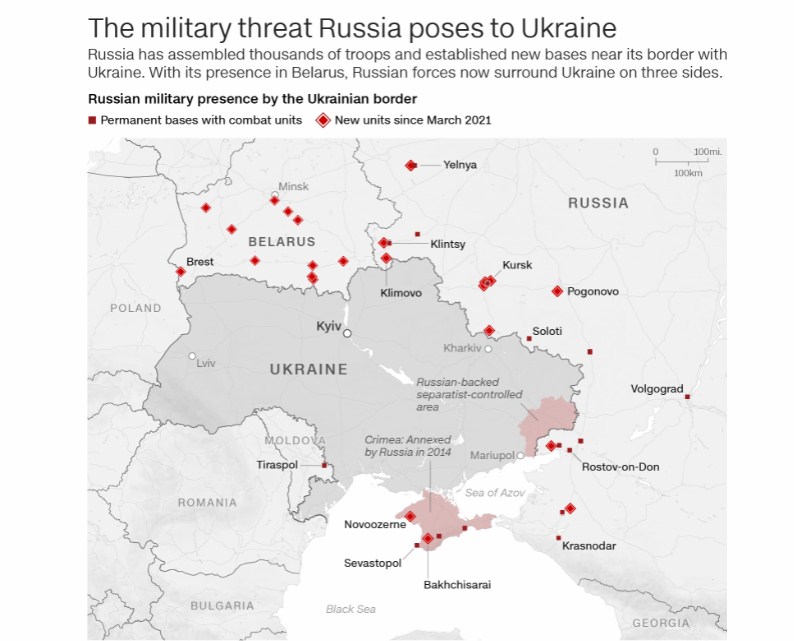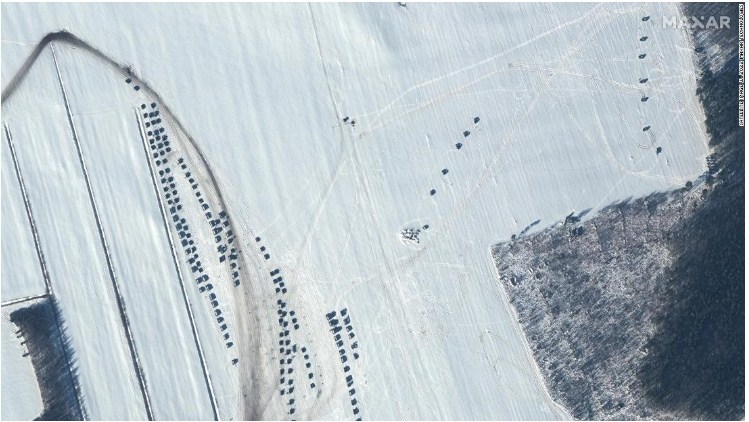[ad_1]
Russia has amassed more than 100,000 troops near the Ukrainian border in recent weeks, according to U.S. estimates, raising fears among Western and Ukrainian intelligence officials that an invasion could be closer than ever.
As frantic diplomatic efforts are made to avert war, analysts warn that the Russian military poses an immediate threat to Ukraine. But if an invasion were to take place, it is not clear where it would begin.
Russia has set up pressure points on three sides of Ukraine – in Crimea in the south, on the Russian side of the border and in Belarus in the north.
Below are the three fronts Ukraine and the West are looking at, and the latest Russian moves uncovered in each of them, according to CNN.

Eastern Ukraine
Most attention has been paid to the separatist regions of Donetsk and Luhansk, where Ukrainian forces and Russian-backed separatists have been in conflict since 2014. The main assumption of those observing Russian movements is that Moscow could increase the military power it already possesses. in the region, thus making eastern Ukraine the easiest position to launch an invasion.
Satellite imagery taken by CNN shows that a large base in Yelnya, which carried Russian tanks, artillery and other armored vehicles, has been largely emptied, with equipment that appears to have moved much closer to the border in recent days.
Large quantities of weapons were moved to the base by the end of 2021 before disappearing – including about 700 tanks, infantry fighting vehicles and ballistic missile launchers. Social media videos show some of those devices on trains and roads much further south in the Bryansk region, which is close to Ukraine. Armatures and vehicles are identifiable by the same units that were previously deployed in Yelnya.

Stephen Wood, director at satellite imaging company Maxar, told CNN: “It looks like a significant amount of vehicles [tanke, artileri vetëlëvizëse dhe automjete të tjera mbështetëse] have started from the northeastern vehicle park; Additional armored vehicles have left the more central vehicle fleet. ”
Meanwhile, increased activity in the Kursk and Belgorod regions, which border northeastern Ukraine, has added to concerns.
“We are seeing a massive influx of vehicles and personnel into Kursk,” warned Konrad Muzyka, an expert on military tracking with Rochan Consulting, on Twitter.
Phillip Karber of the Potomac Foundation in Washington, D.C., who has also studied the movements of Russian troops in detail, told CNN this month:
“Russia’s strongest attacking force – the First Guard Tank Army, which is usually based in the Moscow area – has moved south. “400 kilometers (250 miles) and is accumulating in the optimal area for a rapid armored offensive on the Khursk-Kiev occupation road.”
Belarus
Concerns have also been raised about a large gathering of Russian troops in Belarus, a close ally of Moscow that could provide
another road to Ukraine.
Russia and Belarus on Thursday launched 10 days of joint military exercises, the size and timing of which has sparked fears in the West.
Moscow’s deployment in Belarus is believed to be the largest there since the Cold War, with “an expectation of 30,000 combat troops, special operations forces Spetsnaz, fighter jets including SU-35s, Iskander dual-missile missiles and “S-400 air defense,” said NATO Secretary-General Jens Stoltenberg on 3 February.
It is also the largest exercise the Belarusian Armed Forces has conducted at any time of the year, according to the Center for Strategic and International Studies (CSIS). Russia’s Defense Ministry claimed that the purpose of the exercise, called “Allied Resolve-2022”, was to repel “external aggression”.

Some fear the construction indicates a Russian plan to move toward Kiev from the north. A European diplomat told CNN earlier this month that the mobilization was a “huge, very big concern”, noting that this would be the missing piece that Moscow would need to launch. a rapid attack on the Ukrainian capital.
Joint exercises will also provide coverage for a side movement through Belarus and northern Ukraine, CSIS warns.
And satellite images released by Maxar appear to indicate that the Russian military has advanced deployments to several locations in Belarus. The deployments are likely to be related to joint exercises, but other photos show camps set up near the border with Ukraine, hundreds of miles away from where the exercises are taking place.
However, if Russia were to focus on the Belarus border as its entry point into Ukraine, the road would be fraught with difficulties. Russian soldiers will have to face the Pinsk Swamps, also known as the Pripet Swamps, one of Europe’s largest wetlands, which lies on the border between Belarus and Ukraine – a dense, saturated terrain with water and forests. dense extending to 104,000 square miles.
That region thwarted Nazi forces during Operation Barbarossa, Germany’s doomed invasion of the Soviet Union in 1941. According to the Institute for War Studies, “swamps can be difficult, in some places it is impossible for mechanized forces to they pass when they are wet ”.
Crimea
The peninsula annexed by Russia in 2014 would provide a natural ground for any new operation, but it is unclear whether Moscow will try to launch a move to Ukraine from Crimea.
A large deployment of troops and equipment has been observed by Maxar, who estimates that more than 550 troops’ tents and hundreds of vehicles have arrived north of the Crimean capital, Simferopol. Then a new deployment was identified by Maxar for the first time Thursday near the town of Slavne on the northwest coast of Crimea, including armored vehicles.
These new deployments were noticed on the same day when several Russian warships arrived in Sevastopol, the main port of Crimea. Russia’s Defense Ministry posted images of six large ships in port on Thursday. The Ukrainian navy responded that “Russia continues to militarize the Black Sea region, transferring additional landing craft to put pressure on Ukraine and the world.”
“Ukraine’s naval forces” are ready to develop any scenario and provocation to protect the country from the sea, “he added.
Any movement in southern Ukraine could be assisted by troops in Transnistria, the Russian-backed separatist region of Moldova, where uprisings have also been reported.
CSIS analysts say Russian troops could stage a coup in Odessa, a Ukrainian port city in northwestern Crimea, “sailing its amphibious ships straight to the port of Odessa and moving directly into the city.”
He calls such a move “a high profit, but also a high-risk operation.” Odessa is a populated city and urban fighting there would favor those defending it, while Russian forces would have to eliminate Ukrainian air defenses and then connect with troops arriving from the east of the country. Adapted from CNN.
top channel
[ad_2]
Source link















